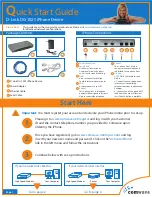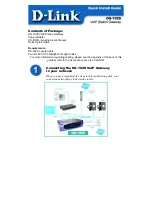
103
Glossary
G
Gatekeeper: An H.323 entity that provides address translation, control access, and sometimes bandwidth management to the LAN for H.323
endpoints.
Gateway: 1. A functional unit that interconnects two computer networks with different network architectures. A gateway connects networks or
systems of different architectures. A bridge interconnects networks or systems with the same or similar architectures. 2. A network that
connects hosts. 3. An H.323 entity that provides real-time, two-way communications between H.323 terminals on the LAN and other ITU
terminals on a WAN, or to another H.323 Gateway.
Graphical User Interface (GUI): A type of computer interface consisting of a visual metaphor of a real-world scene, often of a desktop.
Within that scene are icons, representing actual objects, that the user can access and manipulate with a pointing device.
H
H.323: An umbrella recommendation from the International Telecommunications Union (ITU) that sets standards for multimedia
communications over Local Area Networks (LANs) that do not provide a guaranteed Quality of Service (QoS).
H.323 Endpoint: The clients in an H.323 network. They are typically video conferencing, audio conferencing, or other multimedia systems
implemented by end users to communicate in real time. The H.323 standard requires that every endpoint support the G.711 ITU standard for
speech compression, H.245 protocol for controlling media between H.323 endpoints, Q.931 signal protocol for establishing and terminating
calls, RAS (Registration/Admissions/Status) channel data stream used to communicate with a gatekeeper (optional), and RTP/RTCP (Real-
Time Protocol/Real-Time Control Protocol) for carrying packetized real-time media on IP networks.
H.323 Entity: Any H.323 component, including terminals, Gateways, Gatekeepers, Multipoint Controllers (MCs), Multipoint Processors (MPs),
and Multipoint Control Units (MCUs).
Handshaking: A process that two modems go through at the time of call setup to establish synchronization over the data communications
link. It is a synchronization and negotiation process accomplished by the exchange of predefined, mutually recognized control codes.
High-level Data Link Control (HDLC): An ISO standard, bit-oriented data communications protocol that provides nearly error-free data
transfers.
I
Hexadecimal: A base 16 numbering system used to represent binary values. Hex uses the numbers 0-9 and the letters A-F: usually notated
by an "h" (e.g., "4CF h", read "four charley fox, hex"). The result is that one hex digit represents a 4-bit value.
Implicit congestion management: A method of informing the terminal that the network is busy. This method relies on the end-system
protocol to detect and fix the congestion problem. (TCP/IP is an example of a protocol using only implicit congestion management.) See also
"explicit congestion management".
In-band: Refers to the type of signalling over the conversion path on an ISDN call. Contrast "out-of-band".
Insufficient Ones: A T1 error condition that is logged when less than one 1 in 16 0s or less than 12.5 % average 1s density is received.
Inter Exchange Carrier (IEC): The long distance company (LE) who's central office provides the point of reference for T1 access. Any
common carrier authorized by the FCC to carry customer transmissions between LATAs.
Internet: Refers to the computer network of many millions of university, government and private users around the world. Each user has a
unique Internet Address.
Internet Address (IP Address): A unique 32-bit address for a specific TCP/IP host on a network. Normally printed in dotted decimal format
(e.g., 129.128.44.227).
Internet Protocol (IP): A protocol used to route data from its source to its destination in an Internet environment. The Internet Protocol was
designed to connect to local area networks. Although there are many protocols that do this, IP refers to the global system of interconnecting
computers. It is a highly distributed protocol (each machine only worries about sending data to the next step in the route).
Internetwork Packet Exchange (IPX): A NetWare communications protocol used to route messages from one node to another. IPX packets
include network addresses and can be routed from one network to another. An IPX packet can occasionally get lost when crossing networks,
thus IPX does not guarantee delivery of a complete message. Either the application has to provide that control, or NetWare's SPX protocol
must be used.
Interoperable: Devices from different vendors that can exchange information using a standard's base protocol.
I/O Addresses: Locations within the I/O address space of your computer used by a device, such as an expansion card, a serial port, or an
internal modem. The address is used for communication between software and a device.
IRQ Level (Interrupt Request Level): The notification a processor receives when another portion of the computer's hardware requires its
attention. IRQs are numbered so that the device issuing the IRQ can be identified, and so IRQs can be prioritized.
ISA (Industry Standards Architecture) (pronounced "ice a"): The classic 8 or 16-bit architecture introduced with IBM's PC-AT computer.
Summary of Contents for MultiVOIP 200 MVP200
Page 1: ...Voice Fax over IP Networks Voice Fax Over IP Networks Model MVP200 H 323 Mode User Guide...
Page 5: ...Voice Fax over IP Networks Chapter 1 Introduction and Description...
Page 16: ...16 MultiVOIP 200 User Guide...
Page 17: ...Voice Fax over IP Networks Chapter 2 Installation...
Page 23: ...Voice Fax over IP Networks Chapter 3 Software Loading and Configuration...
Page 51: ...Voice Fax over IP Networks Chapter 4 MultiVOIP 200 Software...
Page 75: ...Voice Fax over IP Networks Chapter 5 Remote Configuration and Management...
Page 83: ...Voice Fax over IP Networks Chapter 6 Warranty Service and Tech Support...
Page 87: ...Voice Fax over IP Networks Appendixes...
Page 96: ...96 MultiVOIP 200 User Guide...
Page 97: ...Voice Fax over IP Networks Glossary...
Page 113: ...113 Index...











































